
Ericameria is a genus of North American shrubs in the family Asteraceae.

Schinia, commonly called flower moths, is a large genus of moths belonging to the family Noctuidae. The genus has a Holarctic distribution with the vast majority of species being found in North America, many with a very restricted range and larval food plant.

Hypena edictalis, the large bomolocha, is a moth of the family Erebidae. The species was first described by Francis Walker in 1859. It is found in North America from Quebec and Maine south to Virginia and Kentucky, west to the foothills of Alberta and the Peace River area of British Columbia.

Schinia jaguarina, the jaguar flower moth, is a moth of the family Noctuidae. The species was first described by Achille Guenée in 1852. It is found on North America's Great Plains from Saskatchewan and Alberta south to Texas, eastward on coast to Florida and westward in south to Arizona. In Mexico it is found down to Mexico City.
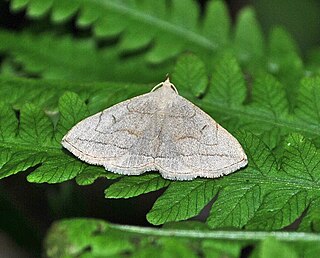
Zanclognatha pedipilalis, the grayish zanclognatha, is a litter moth of the family Erebidae. The species was first described by Achille Guenée in 1854. It is found in eastern North America, from Nova Scotia south to Florida and Mississippi, west to Alberta and Kansas.

Schinia roseitincta is a moth of the family Noctuidae first described by Leon F. Harvey in 1875. It is found in the northern United States and in Canada.
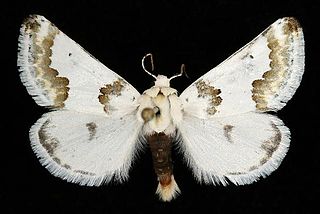
Schinia cumatilis, the silver-banded gem, is a moth of the family Noctuidae. The species was first described by Augustus Radcliffe Grote in 1865. It is found from the Southwestern United States into Southern Canada.

Schinia honesta, or the black-spotted gem, is a moth of the family Noctuidae. The species was first described by Augustus Radcliffe Grote in 1881. It is found in southern Canada and California. The wingspan is about 25–26 mm.

Schinia acutilinea, the angled gem or acute-lined flower moth, is a moth of the family Noctuidae. The species was first described by Augustus Radcliffe Grote in 1878. It is found in the dry southern portions of Saskatchewan, Alberta and British Columbia, south across the plains and Great Basin to southern Arizona and California.

Schinia meadi, or Mead's flower moth, is a moth of the family Noctuidae. The species was first described by Augustus Radcliffe Grote in 1873. It is found in western North America from south central Saskatchewan and central Alberta west to south central Washington, south to Arizona and New Mexico.
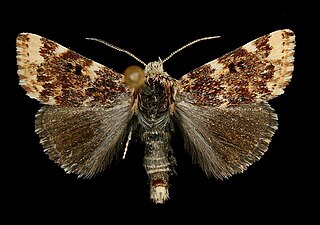
Schinia avemensis, the gold-edged gem, is a moth of the family Noctuidae. The species was first described by Harrison Gray Dyar Jr. in 1904. It is found in only three colonies in the southern prairie provinces of Canada, the Spirit Dunes at Spruce Woods Provincial Park, Manitoba; the Burstall dunes in south-western Saskatchewan; and in a small dune complex in the Red Deer River valley north of Bindloss. It will probably also be found in other active dune complexes in the southern parts of Alberta and Saskatchewan. It has also been recorded from Colorado.

Schinia nuchalis, the spotted sage moth, is a moth of the family Noctuidae. The species was first described by Augustus Radcliffe Grote in 1878. It is found from the Great Plains and Great Basin, from southern Saskatchewan, Alberta and British Columbia south to northern Arizona. The Eurasian Schinia scutosa is no longer considered a synonym of Schinia nuchalis.
Schinia persimilis, the persimilis flower moth, is a moth of the family Noctuidae. The species was first described by Augustus Radcliffe Grote in 1873. It is found from in western North America from east central Alberta and the Cypress Hills in Saskatchewan north to the southern Yukon, west and south to Colorado, Utah, California and Oregon.
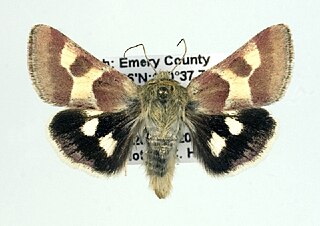
Schinia suetus is a moth of the family Noctuidae first described by Augustus Radcliffe Grote in 1873. It is widespread in the mountains of western North America, from southern Alberta west to British Columbia, south at least to Colorado and California, east to Idaho and New Mexico.

Schinia villosa, the little dark gem, is a moth of the family Noctuidae. The species was first described by Augustus Radcliffe Grote in 1864. In North America, it is mostly a western mountain species, however it has also been found across the plains eastward across Alberta and Saskatchewan to southern Manitoba. To the west it is found up to the coast ranges of Washington and British Columbia, south to Arizona.

Schinia nundina, the goldenrod flower moth, is a moth of the family Noctuidae. The species was first described by Dru Drury in 1773. It is found in North America from Minnesota to southern Ontario and Nova Scotia, south to central Florida and southern Texas. Records include Arizona, Kansas, Nebraska, New York, Maryland, Oklahoma and South Carolina.
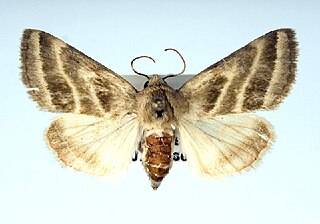
Schinia trifascia, the three-lined flower moth, is a moth of the family Noctuidae. The species was first described by Jacob Hübner in 1818. It is found in North America from Ontario and Massachusetts south to Florida and west to Arizona, Colorado and Wyoming. It has also been reported from Louisiana.

Schinia scutosa, the spotted clover, is a moth of the family Noctuidae. It is found from Europe to southern Siberia, the Near East and the Middle East and from central Asia to Japan. In North Africa it is found from Morocco to Egypt.

Schinia nubila, the camphorweed flower moth or brown flower moth, is a moth of the family Noctuidae. The species was first described by Herman Strecker in 1876. It is found from the US states of Oklahoma to New Jersey, south to Florida and Texas. Its range is expanding in the northeast. Furthermore, recorded from Colorado, Kansas, Oklahoma, Arkansas, North Carolina, South Carolina and Maryland.

Nematocampa resistaria, the filament bearer, bordered thorn or horned spanworm moth, is a moth of the family Geometridae. The species was first described by Gottlieb August Wilhelm Herrich-Schäffer in 1856. It is found in North America from British Columbia to Nova Scotia, south to Florida and California.


















